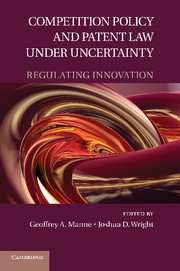Book contents
- Frontmatter
- Contents
- Contributors
- Introduction
- PART I THE INSTITUTIONS OF GROWTH
- PART II THE ECONOMICS OF INNOVATION
- 3 Bundling and Unbundling in New Technology Markets
- 4 Unlocking Technology
- 5 Creative Construction
- PART III INNOVATION AND COMPETITION POLICY
- PART IV THE PATENT SYSTEM
- PART V PROPERTY RIGHTS AND THE THEORY OF PATENT LAW
- PART VI INTELLECTUAL PROPRETY AND ANTITRUST: THE REGULATION OF STANDARD-SETTING ORGANIZATIONS
- Index
- References
4 - Unlocking Technology
Antitrust and Innovation
Published online by Cambridge University Press: 05 June 2012
- Frontmatter
- Contents
- Contributors
- Introduction
- PART I THE INSTITUTIONS OF GROWTH
- PART II THE ECONOMICS OF INNOVATION
- 3 Bundling and Unbundling in New Technology Markets
- 4 Unlocking Technology
- 5 Creative Construction
- PART III INNOVATION AND COMPETITION POLICY
- PART IV THE PATENT SYSTEM
- PART V PROPERTY RIGHTS AND THE THEORY OF PATENT LAW
- PART VI INTELLECTUAL PROPRETY AND ANTITRUST: THE REGULATION OF STANDARD-SETTING ORGANIZATIONS
- Index
- References
Summary
Introduction
“Technology lock-in” has joined the pantheon of highly honored justifications for government intervention in innovation that should be laid to rest. The concept of technology lock-in has begun to exert influence in antitrust policy, appearing in Microsoft v. Commission. Advocates argue that technology lock-in occurs when markets adopt an inferior technology and that government action is required to remedy the situation. Yet, the notion that governments can make the best choice among innovations, while markets cannot, is the “fatal conceit” of technology lock-in.
In this chapter I demonstrate that the arguments supporting the idea of technology lock-in are fundamentally flawed, as is much of the evidence for the phenomenon. The desirability of government intervention is suspect as well, particularly as government remediation is built right into the definition of the problem. I show how markets effectively coordinate decisions to adopt innovations. Market participants have economic incentives to make efficient choices among innovations. The concept of technology lock-in thus is likely to misguide public policy. To avoid disrupting incentives for innovation, public policy-makers should exercise more forbearance than usual in markets for technology.
The concept of technology lock-in predicts market failure on a colossal scale. For Brian Arthur, the economy experiences “lock-in by history.” Since technological advances are ubiquitous in the modern economy, such a systematic market failure potentially would entail losses equal to a substantial share of the gross domestic product.
- Type
- Chapter
- Information
- Competition Policy and Patent Law under UncertaintyRegulating Innovation, pp. 120 - 165Publisher: Cambridge University PressPrint publication year: 2011



